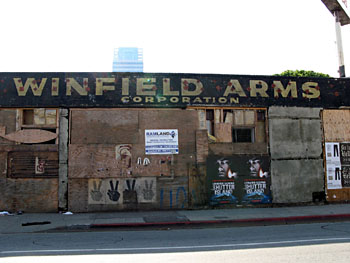 |
||||||||||||||||||||||||||||||||||||
|
The Western Arms Corporation by Ed Buffaloe I doubt that much would be known about the Western Arms Corporation of Los Angeles (also known as Winfield Arms Corporation) if Sam Cummings hadn’t been associated with it briefly in 1952. Little enough is known. Cummings (1927-1998) was the famed founder of Interarms, and the largest arms dealer in the world during the second half of the 20th century. My interest in the two companies arose because they were the importers and distributors of MAB pistols in the United States after World War II. Most of the references I found about Western Arms and Winfield Arms came from books about Sam Cummings and/or the international arms trade. Western Arms Corporation1 Thus far, the two books I have encountered with the most information about Western Arms are George Thayer’s The War Business: The International Trade in Armaments and Brogan and Zarca’s Deadly Business: Sam Cummings, Interarms, and the Arms Trade. Of the two, I feel the latter is the more reliable since it is based on interviews with Sam Cummings, who cooperated with the authors while they were writing the book, going so far as to read and correct it before publication. But Brogan and Zarca quote Thayer, and Thayer’s book deals with issues outside the scope of the book about Cummings and Interarms. Another book that covers much of the same information is Weapons: The International Game of Arms, Money and Diplomacy, by Russell Warren Howe.
An early CIA decision was to bring war surplus in Europe to the United States, rather than let it fall into the hands of left-wing movements. Some of the guns would also, it was reasoned, be useful as “sterile” weapons (foreign-made and untraceable to the United States) to be provided secretly to foreign friends. Two firms were set up to handle this trade: one was WAC, headed by Hollywood promoter Leo Lippe.
While there is no doubt that Leo Lippe was involved in the firearms trade and was associated with Western Arms, Winfield Arms, and Hy Hunter in the 1950’s and 1960’s, according to Brogan and Zarca his only connection to the CIA prior to 1951 was that he had sold the OSS some cooking equipment during the war. The CIA used Lippe’s Hollywood connection as a cover for Sam Cummings’ mission to Europe to buy surplus weapons (they were ostensibly buying them for the movies) but, according to Brogan and Zarca, at the time Lippe knew nothing about weapons and had never traveled outside the U.S. Lisa Beth Pulitzer, in her book A Woman Scorned, states that Lippe did not know the true purpose of his mission with Cummings, but this seems to be contradicted by some statements in Brogan and Zarca’s book. Supposedly, it was during this European trip with Cummings that Lippe gained some knowledge about, and developed an interest in, weapons--and only after he returned did he decide to go into the arms business. According to Brogan and Zarca, Western Arms was “founded after the war by Robert Lee, a California arms dealer, and an Englishman, Cecil Jackson.” The company filed for bankruptcy in 1950, but was apparently rescued by Leo Lippe, when he and Cummings began buying arms for the CIA. Brogan and Zarca do not mention any CIA connection with Western Arms prior to 1951, but they do state that Sam Cummings “...collaborated with Western Arms, which certainly had close associations with the CIA.”
There is a brief mention of Western Arms in Dillinger: The Untold Story, which simply states that it may have been the successor to the Monarch Arms Company of Los Angeles, which manufactured custom parts for automatic pistols circa 1933. I’m dubious about this assertion and have been unable to find any further information about Monarch Arms. Western Arms is mentioned in Stephen Cuthbertson’s book Worldwide Webley. The Australian Police bought 250 of the Webley & Scott .380 auto pistols to replace some of their Smith & Wesson revolvers in 1912. Much later, in the 1950's, hundreds of ex-police and confiscated pistols of all sorts were dumped at sea. But divers kept bringing them back up, so later guns were melted down. Cuthbertson writes: "However, some of the confiscated or surrendered pistols and revolvers were sold to the Western Arms Corporation of Los Angeles, California in February 1953. One hundred and nine pistols and revolvers of various makes were purchased by the company for $171US. These pistols were later distributed to dealers in Canada and the United States." The Dublin Police ordered 200 W&S auto pistols in 1920--50 in .32 caliber and 150 in .380 caliber. Cuthbertson writes: "Then, in 1925 the Metropolitan Dublin Police Force was reorganized to become part of the Federal Garda Siochana. The Webley & Scott Automatics were used until the mid 1930's when they were placed in reserve storage. As with some of the South Australian Pistols, the Western Arms Company of Los Angeles, California managed to purchase these when they were finally declared surplus by the Irish Government in 1951." I suspect Sam Cummings brokered this transaction. The earliest address that appeared on Western Arms ads was 1206 Maple Avenue, Los Angeles 15, California--in 1949. By 1950 they were at 417 E. Pico Boulevard, Los Angeles 15, California . I have located an ad from 1953 that gives their address as 411 E. Pico Boulevard, and two others from January 1954 that shows them at 409 E. Pico. The January 1954 ads for the WAC R9 pistol made by MAB are the last I have been able to locate for Western Arms. By February of 1954 the WAC pistols were being marketed by Winfield Arms. Winfield Arms Corporation2
There are many advertisements for Winfield Arms in old gun magazines from the 1950’s, as well as in Popular Science and Popular Mechanics. The earliest advertisement I’ve been able to locate is from December of 1951 in American Rifleman. This ad lists the address of Winfield Arms Corporation as 409 East Pico Boulevard, Los Angeles 15, California. The Winfield Arms address at 409 East Pico is separated from the Western Arms address at 417 East Pico by one small storefront. Later advertisements, from the mid-1950’s, give the address for Winfield Arms as 1006 South Olive, Los Angeles 15, California. In 1963, their last advertisements shows them at 10927 W Pico Boulevard. The earliest advertisements for Winfield Arms Corporation (dating from 1951) state that it is the distributor for Western Arms Corporation. These early ads are the only hard link I’ve been able to find between the two entities, which were essentially the same company. Incorporation papers for the Winfield Arms Corporation were filed on 25 January 1951, right about the time Lippe and Cummings were being sent overseas to buy arms for the CIA. Winfield eventually became the public face of the corporation, handling distribution, while the purchase and importion of arms continued under the Western Arms Corporation name. Western Arms continued to advertise the MAB/WAC pistols through January of 1954. In 1953 Winfield Arms bought all the Johnson Automatic Rifles held as surplus in the U.S., which they refurbished and sold through the mid-1960’s. Many of their advertisements in 1953 and 1954 were for these rifles. Winfield Arms also imported and rebranded .41 Swiss rimfire cartridges made in Italy by Leon Beaux. Winfield sold surplus weapons from all over the world, including Remington rolling block rifles, Martinis, Mausers, Terni carbines, Ross .303 rifles, Swiss Vetterlis, Webley revolvers, Swedish Lahti pistols, as well as sabers, bayonnets, and gun stocks. Speculations and a Few Known Facts
I suggest that the name “Western Arms Corporation” was no accident. The CIA set up a company that was in clear opposition to the “Eastern bloc,” so its name reflected its purpose, which was to provide arms to Western bloc allies. Since the company was in California, people in the U.S. assumed the name referred the Western U.S. rather than the Western World. In my opinion, at some point the CIA decided that the Western Arms name might be a bit too obvious, so they began using the name Winfield Arms for their sales. Cecil Jackson, one of the founders of Western Arms, served in the British Army’s Jewish Brigade during World War II. The Jewish Brigade saw action fighting the Germans in Italy in 1944. Jackson had close ties to Israeli intelligence, as well as the CIA. Cecil’s son, Nigel, also worked for Winfield Arms, but I do not know if he was connected in any way with the intelligence community. Steve Kessler was a CIA employee who worked for Winfield Arms in the late 1950’s and early 1960’s. Around 1962 he left to work for World Arms Corporation, which was a California company founded on 17 November 1947, a mere two months after the official establishment of the CIA. I haven’t been able to learn anything more about World Arms, but it may also have been established by the CIA. Kessler has also been linked with INCO of Burbank, California.
According to Mark Kurlansky, in his book The Basque History of the World, "[t]he Basque Nationalist Party and the OSS ... worked hand in hand.” The Basque Nationalist Party had formed the Guernica Battalion to fight with De Gaulle’s resistance forces in Southern France. Composed largely of men who had fought for the Republic in the Spanish Civil War, the Guernica Battalion was armed and trained by the OSS. Clearly there were men in the OSS who had contacts with Basque members of the French resistance in Bayonne, which also happens to be the location of MAB (Manufacture d’Armes de Bayonne). I believe Western Arms/Winfield Arms was dissolved and the assets sold, possibly as early as 1960 or as late as 1962. Seaport Traders began advertising MAB pistols in 1960, and in 1961 advertised a Model C with WAC markings. Advertisements for Winfield Arms disappeared from the usual magazines after 1963, and Sam Cumming’s distributing company, Hunters Lodge, began running ads for MAB pistols (the GZ and Le Chasseur) in September of 1962. I strongly suspect that Cummings bought remaining stock when the CIA decided to make Western Arms disappear. 1. There was a Western Arms Company that sold cap-lock revolvers in New York City during the American Civil War, and also a Western Arms and Cartridge Company based in Chicago that was purchased by Winchester after World War II. Neither of these companies are related in any way to the Western Arms Corporation of Los Angeles. 2. Winfield Arms Company was originally a brand name for suicide special revolvers made by the Crescent Arms Company of Norwich, Connecticut, and later was used on shotguns made by the same company up until about 1917. Interestingly, Monarch Arms was also a trade name for suicide special revolvers made by Hopkins & Allen, Johnson & Bye, and Iver Johnson. However, none of these earlier companies have any relationship to the company I am writing about.
|
||||||||||||||||||||||||||||||||||||
|
Copyright 2010-2012 by Ed Buffaloe. All rights reserved. |
||||||||||||||||||||||||||||||||||||
|
|
||||||||||||||||||||||||||||||||||||

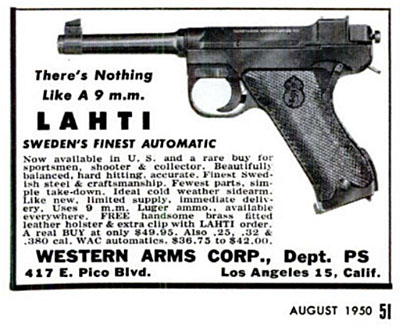 The Central Intelligence Agency was formed
by the National Security Act of 1947, which became effective on 18 September 1947. Western Arms filed its incorporation papers on 15 May 1948. Advertisements for Western Arms began appearing in American Rifleman, Popular Mechanics, and Popular Science
magazines in October of 1949. Leo Lippe and Sam Cummings were sent to Europe in 1951 to buy surplus weapons for the CIA. The involvement of Western Arms in the purchase and importation of CIA weapons is often
implied, but not stated explicitly in the above-referenced books. However, after the European trip, Cummings was sent to Costa Rica by the CIA to oversee the sale of that country’s
surplus small arms to the Western Arms Corporation. Multiple sources indicate that Cummings worked for Western Arms for as much as two years, but Brogan and Zarca indicate that his true employer was the CIA.
The Central Intelligence Agency was formed
by the National Security Act of 1947, which became effective on 18 September 1947. Western Arms filed its incorporation papers on 15 May 1948. Advertisements for Western Arms began appearing in American Rifleman, Popular Mechanics, and Popular Science
magazines in October of 1949. Leo Lippe and Sam Cummings were sent to Europe in 1951 to buy surplus weapons for the CIA. The involvement of Western Arms in the purchase and importation of CIA weapons is often
implied, but not stated explicitly in the above-referenced books. However, after the European trip, Cummings was sent to Costa Rica by the CIA to oversee the sale of that country’s
surplus small arms to the Western Arms Corporation. Multiple sources indicate that Cummings worked for Western Arms for as much as two years, but Brogan and Zarca indicate that his true employer was the CIA.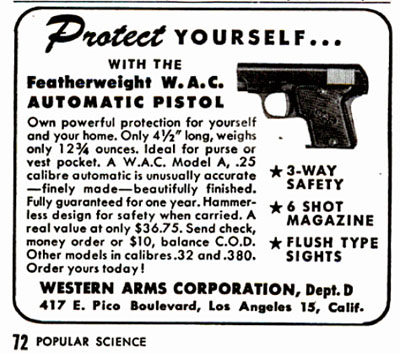 Thayer states that Lippe was not associated
with Western Arms when Cummings worked with the company during his stint with the CIA. However, Brogan and Zarca state that “Cummings worked with Lippe during this period and got to know Western Arms and
Cecil Jackson.” After he left the CIA at the end of 1952 and went into business for himself, Cummings’ first big purchase of weapons was from Panama, and he sold them
to Cecil Jackson of Western Arms. Cummings continued to sell guns to Western Arms through his distributor, Hunters Lodge, probably right up to the time they went out of business, sometime in the early to mid- 1960s.
Thayer states that Lippe was not associated
with Western Arms when Cummings worked with the company during his stint with the CIA. However, Brogan and Zarca state that “Cummings worked with Lippe during this period and got to know Western Arms and
Cecil Jackson.” After he left the CIA at the end of 1952 and went into business for himself, Cummings’ first big purchase of weapons was from Panama, and he sold them
to Cecil Jackson of Western Arms. Cummings continued to sell guns to Western Arms through his distributor, Hunters Lodge, probably right up to the time they went out of business, sometime in the early to mid- 1960s.
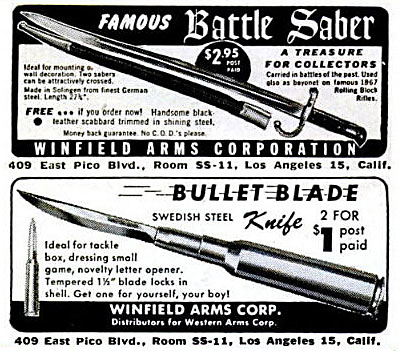 Information about the Winfield Arms Corporation of Los Angeles is hard to come by. As quoted above, Thayer stated that Leo Lippe convinced the CIA to set him up first as Western Arms, then as Winfield Arms, but
Brogan and Zarca state that Leo Lippe only became associated with Western Arms after it had been in business for three years.
Information about the Winfield Arms Corporation of Los Angeles is hard to come by. As quoted above, Thayer stated that Leo Lippe convinced the CIA to set him up first as Western Arms, then as Winfield Arms, but
Brogan and Zarca state that Leo Lippe only became associated with Western Arms after it had been in business for three years.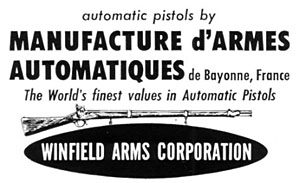 According to a source who once worked for Winfield
Arms, Western Arms/Winfield Arms was set up by the CIA and was partially staffed by CIA and Office of Naval Intelligence personnel throughout its existence. The sole purpose of the company was to purchase arms on the
international market and make them available to governments or political entities supported by the CIA, including foreign intelligence services. The company’s
commercial business was real and quite extensive, but served as a cover for the clandestine activities of American intelligence agencies. Western/Winfield provided arms to various Central
American countries, Mexico, Chile, and Israel, among others.
According to a source who once worked for Winfield
Arms, Western Arms/Winfield Arms was set up by the CIA and was partially staffed by CIA and Office of Naval Intelligence personnel throughout its existence. The sole purpose of the company was to purchase arms on the
international market and make them available to governments or political entities supported by the CIA, including foreign intelligence services. The company’s
commercial business was real and quite extensive, but served as a cover for the clandestine activities of American intelligence agencies. Western/Winfield provided arms to various Central
American countries, Mexico, Chile, and Israel, among others.